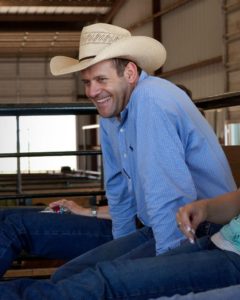Total Earnings: $9,227,718 
How did you get started in cutting?
“As a young boy in 1975 I wanted to meet a cowboy, so my parents took me to the Cow Palace and I met Leo Camarillo and his wife. My parents developed a friendship with them and I have always had a love of horses ever since I was born. And my dad was looking for a way to semi-retire to the country…We got introduced to cutting and reined cow horse and went to the Snaffle Bit Futurity but I really had a fondness for cutting so my interest and passion grew from there.”
Who did you work for?
“I never worked for anyone, we had several trainer’s working for us…. In 1985, Todd Bimat came to work for us at our ranch in Napa. And we started showing and having some success. Rock Hedlund leased our ranch for 5 years so I worked some with Rock Hedlund. I spent 6 weeks with Tom Lyons and I spent a lot of time with Mike Mowry, Lindy Burch and Curly Tully.”
Do you have any superstitions when it comes to picking cows?
“If I can find a cow with a little white stripe up his shoulder…I’ve had people for years say that’s a Phil Rapp cow. A little bit of a paint stripe that goes up over either shoulder, for whatever reason I think those cattle are really good. Sometimes I don’t get to cut them, but we’ll pick them out. I try not to be too prejudiced, but there’s a saying in Fort Worth, ‘you don’t cut a tiger stripe,’ but if that cow acts really well, go ahead. Sometimes for me in Will Rogers the smokier [colored] cattle I’ve lost or they have taken me out of the cuttings over the years. If I can stay away from cutting a charcoal or smokey cow I will.”
What advice do you have for someone just getting involved in the sport?
“Don’t jump in with both feet. Take your time, get your bearings about you within the business. Find somebody that you trust that has a good reputation and begin a relationship with that person and listen to what they have to say. And try to buy the very best horse that you can afford to buy. After you write the check for the horse, everything else costs the same. The better the horse you buy, the better the phone conversations are. If you buy a horse that isn’t very good and the customer calls and asks how they are doing, those phone conversations aren’t very comfortable.”
What is the most important quality you must have in a horse in training?
“If you have a horse with a great mind but not the most athletic ability you probably won’t win a lot, but that horse is at least going to help. If you have a horse that is extraordinarily athletic, but without a good mind or trainability, you’re going to be frustrated because that horse is going to cause you a lot of [grief]… Those horses that are consistently successful have a trainable, willing mind and they have athleticism to be able to do what we need them to do today. Whatever level, the mind is the most important thing.”
What is the most rewarding thing about being a cutting horse trainer?
“I think training a horse and watching that horse develop. That is very rewarding. Every cutting horse trainer has customers that they work with and it’s very rewarding when you can take a customer and help them fulfill their dreams and experience success through your work and education and commitment, that’s very rewarding. As you help people as turnback or herd holder, it’s rewarding to help them succeed as well.” What is the hardest thing about being a trainer? “The lack of success or the failure rate. Unfortunately, cutting is based on an 80% failure rate … but you have to realize that you did your job sometimes and you were successful even when your score may not reflect it and that you advanced that horse.”
